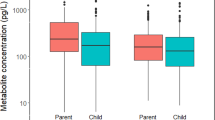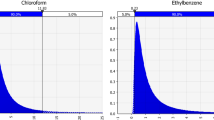Abstract
Children in low-income families may have high exposures to polycyclic aromatic hydrocarbons (PAH). Such exposures could result from household proximity to heavy traffic or industrial sources, environmental tobacco smoke, contaminated house dust or soil, among others. The objectives of this study were: to establish methods for measuring total PAH exposure of children in low-income families, to estimate the PAH exposures of these children, and to estimate the relative importance of the environmental pathways for PAH exposure. Analytical methods to determine PAH in air, dust, soil, and food and to determine hydroxy-PAH in urine samples were evaluated and validated. A two-home pilot study was conducted in downtown Durham, North Carolina (NC) during February 1994. One smoker's and one nonsmoker's household, which had preschool children and income at or below the official U.S. poverty level, participated. A nine-home winter and a nine-home summer study were conducted in Durham and the NC Piedmont area during February 1995 and August 1995, respectively. A summer study in four smokers' homes was also conducted. In each of these studies, multimedia samples were collected and analyzed for PAH or hydroxy-PAH. Summary statistics, Pearson correlations, and analysis of variance were performed on the combined data from these four field studies. An effective screening method was established for recruiting low-income families. The field protocol involved measurements of three homes in 2-day periods. This protocol should be suitable for large-scale studies. The results showed that indoor PAH levels were generally higher than outdoor PAH levels. Higher indoor PAH levels were observed in the smokers' homes compared to nonsmokers' homes. Higher outdoor PAH levels were found in inner city as opposed to rural areas. The relative concentration trend for PAH in dust and soil was: house dust > entryway dust > pathway soil. The PAH concentrations in adults' food samples were generally higher than those in children's food samples. Children's potential daily doses of PAH were higher than those of adults in the same household, when intakes were normalized to body weights. Inhalation is an important pathway for children's exposure to total PAH because of the high levels of naphthalene present in both indoor and outdoor air. Dietary ingestion and nondietary ingestion pathways became more important for children's exposure to the B2 PAH (ranked as probable human carcinogens, B2 by the U.S. EPA's Integrated Risk System), most of which are of low volatility. The analysis of variance results showed that inner city participants had higher total exposure to B2 PAH than did rural participants.
This is a preview of subscription content, access via your institution
Access options
Subscribe to this journal
Receive 6 print issues and online access
$259.00 per year
only $43.17 per issue
Buy this article
- Purchase on Springer Link
- Instant access to full article PDF
Prices may be subject to local taxes which are calculated during checkout
Similar content being viewed by others
Author information
Authors and Affiliations
Corresponding author
Additional information
The information in this document has been funded wholly or in part by the United States Environmental Protection Agency under Cooperative Agreement CR822073, to Battelle. It has been subjected to Agency Review and approved for publication. Mention of trade names or commercial products does not constitute endorsements or recommendations for use.
Rights and permissions
About this article
Cite this article
CHUANG, J., CALLAHAN, P., LYU, C. et al. Polycyclic aromatic hydrocarbon exposures of children in low-income families1. J Expo Sci Environ Epidemiol 9, 85–98 (1999). https://doi.org/10.1038/sj.jea.7500003
Received:
Accepted:
Published:
Issue Date:
DOI: https://doi.org/10.1038/sj.jea.7500003
Keywords
This article is cited by
-
Biomarkers for polycyclic aromatic hydrocarbons in human excreta: recent advances in analytical techniques—a review
Environmental Geochemistry and Health (2023)
-
Characteristics of particle-bound polycyclic aromatic hydrocarbons (PAHs) in indoor PM2.5 of households in the Southwest part of Ulaanbaatar capital, Mongolia
Environmental Monitoring and Assessment (2022)
-
The influence of demographic and lifestyle factors on urinary levels of PAH metabolites—empirical analyses of Cycle 2 (2009–2011) CHMS data
Journal of Exposure Science & Environmental Epidemiology (2021)
-
Opportunities for evaluating chemical exposures and child health in the United States: the Environmental influences on Child Health Outcomes (ECHO) Program
Journal of Exposure Science & Environmental Epidemiology (2020)
-
Distribution, Sources and Health Risks of Polycyclic Aromatic Hydrocarbons (PAHs) in Household Dusts from Rural, Semi-urban and Urban Areas in the Niger Delta, Nigeria
Exposure and Health (2019)



